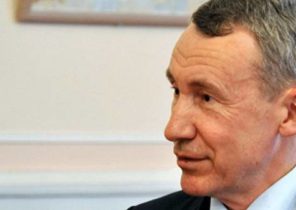
In the collective memory of Ukrainians have a lurking nightmare. It is so terrible that it cannot be said openly — as if mentioning it aloud, you will turn it into reality: this is the risk of new accidents at nuclear power plants. The Chernobyl accident in 1986 left an indelible trace in the national history of Ukraine: the accident that had terrible consequences in the history of nuclear energy, is part of the collective consciousness, and still my memories of her evoke the deepest feelings.
Despite the devastating consequences for the country and Europe, not just Ukraine is not closed until 2000, the Central nuclear power plant in Chernobyl — in the country still has four nuclear power plants. From these nuclear power plants, in which, I must say, used technologies different from those used at Chernobyl. Depends on a large part of the energy supply of the country, and they have long been a concern among experts.
At the moment there are four nuclear power plants — Khmelnytsky, Rivne, South-Ukrainian and Zaporizhzhya. In total there is 15 units. All the stations were built in Soviet times with state funds. Responsible for Russia, which the current government in Kiev is fighting.Aging nuclear power plants is a serious problem. “Our station — old — explains Dmitry marunich, co-President of Energy Strategies Fund. — Operating period should not exceed 30 years, but seven reactors are already older.”
“A few years some reactors cannot be used, and they will be turned off forever. In 2025, the closure of these stations will reduce the amount of energy produced, which can not be offset by performance of other reactors”, — he said.
Only nuclear energy gives light to Ukraine
However, year after year, electricity generation at these stations is only growing. In 2011, nuclear energy accounted for 47.2 per cent of all electricity produced in the country. At the moment — after the war was lost an important natural deposits of coal in the Donbas — the figure is closer to 60%.
The President of Ukraine Petro Poroshenko proudly emphasizes this fact, referring to the so-called economic independence of Ukraine. However, this fact should be of concern: power stations are unable to increase productivity in response to increased demand for electricity.
While the performance of power plants with a utilization rate of production capacity above 90% is about 11-12 thousand megawatts, the peak consumption level is 16-17 thousand megawatts. “This difference can be offset only with nuclear energy,” he says.
In November 2014 one of the reactors of the Zaporizhzhya NPP was for some time disabled. Perhaps it was due to the fact that it was overloaded or out of date (although in may 2015, there was a request for an extension of operation). It was a temporary issue that this, along with low productivity of the Ukrainian power grid could cause blackouts in many parts of the country and has caused great concern among the population.
Of course, this incident, like others, did not cause leakage of radioactive substances and increase of level of radiation, which is monitored by international institutions. Experts almost unanimously urge to build a new power plant.
Political issue — fuel and waste
In truth, this theme is especially difficult, including due to the fact that affects the most sensitive areas of international politics that emerged after the revolution on the Maidan in 2014.
To break free from energy dependence on Moscow, Ukraine appealed to the American company Westinghouse for the purchase of nuclear fuel. However, in 2012 it turned out that the fuel assemblies manufactured by the American company, unserviceable and was banned. Losses of Ukrainian state company Energoatom in charge of nuclear power plants, amounted to $ 175 million.
Now, when the agreement was renewed and extended until 2020, Westinghouse said that not taking the spent fuel, forcing Ukraine (and it is in a dire financial conditions) to seek urgent solution for storing waste, which it obviously can’t be sent to Russia, as has been done before.
Russian know-how
However, politics determine not only the choice of sources of replenishment of stocks of fuel and waste disposal.
The coming to power of the Pro-Western government and mainly military confrontation with Russia off nuclear power plants of Soviet production from those who engineered that caused a lot of problems associated with their use.
“After 2014, the Kiev government has terminated the contract with OKB “Gidropress”, developed by Ukrainian nuclear reactors, explains the Russian edition of “Vesti” Alexander Artyukov, who has worked there for almost 20 years. — This makes it impossible to exercise full control, it can only do designer”.
And as if that wasn’t enough, a report released in 2016, a leading authority Energy Research & Social Science, stressed that “for many years the accident at the Ukrainian nuclear power plants are not recorded in the database, despite reports in the state media”. Special emphasis was placed on creating a “centralized and completely transparent source of truth”.
The threats associated with corruption
However, transparency in this area — a rarity: on 30 March this year the American edition of the Washington Times reported: “NPP must be in the office of the State nuclear regulatory Inspectorate of Ukraine, of the service that is required by law to be independent. However, in recent years the common practice when heads of inspection appointed by the state company “Energoatom””.
The risk for the country, which occupies the 131-th place out of 176 in the corruption index compiled by Transparency International, obviously high.
Therefore, the risk of corruption, the isolation of Russia, the difficulty of finding fuel and waste processing, obsolete station, exposed to excessive loads — all of these factors is of great concern.
Of course, hardly ever encounter the same conditions that led to the Chernobyl accident. But the study ERSS made on the basis of statistical calculations about the risks of new accidents, leads to disappointing conclusions: “Despite the fact that 1986 was a turning point in terms of number of accidents, it had no effect on the scale of individual incidents… analysis of the data indicates the probability of an accident is significant on one of the Ukrainian nuclear power plants. For example, the probability of an accident like the one that occurred in 1979 at the nuclear power plant Three Mile island, or Rivne South Ukraine NPP in the next 5 years is 80%”.
In light of the above, one can fully understand the appeal of Marunich: “If Europe will not solve the problems of the Ukrainian nuclear power plants in the next five to seven years, to worry about have all over the Old world, not just Ukraine.”







